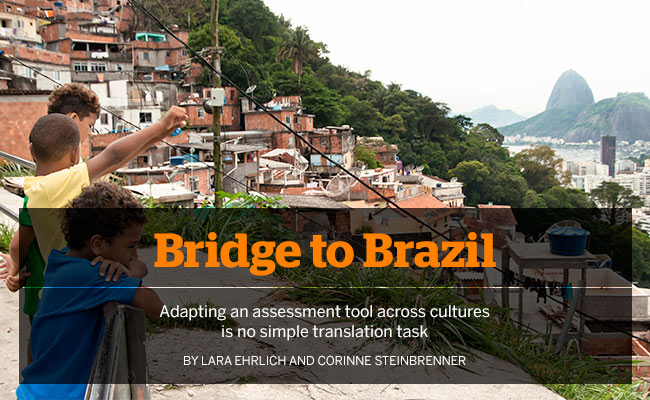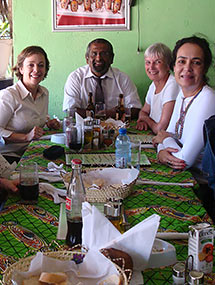Bridge to Brazil

Can your child use a straw? Walk up a flight of stairs without a handrail? Ask permission to borrow a friend’s toy? Children with physical or behavioral disabilities may struggle with these and other tasks—challenges that therapists must consider as they work with parents to design individualized rehabilitation programs.

The Pediatric Evaluation of Disability Inventory (PEDI), a functional assessment for children up to age seven, tests proficiency in mobility, daily activities, and social/cognitive skills to help therapists construct rehabilitation programs for children with disabilities. Developed by Wendy Coster, a professor and chair of the Department of Occupational Therapy, and a team of colleagues, the instrument has become widely used in the United States and other countries—including Sweden, Australia, Israel, Slovenia, Hong Kong, Iceland, and Italy—since its introduction 22 years ago. Coster’s former student Marisa Mancini (’97) brought the tool to her native Brazil, where it has inspired a profound shift in the rehabilitation field.
In 1992, Coster had just launched the PEDI when Mancini arrived at Sargent College on a Brazilian government scholarship to pursue a Doctor of Science degree; Mancini translated the assessment into Portuguese as part of her doctoral work. Upon returning to Brazil, she and her husband, Sérgio Fonseca (’97), helped to build a highly ranked rehabilitation sciences program at the Universidade Federal de Minas Gerais (UFMG). Mancini, now a professor of occupational therapy and rehabilitation sciences at UFMG, introduced the PEDI in Brazil as an alternative to the tests in use at the time, which she believed did not adequately serve children with disabilities.
Prior to the PEDI, the pediatric assessment tools employed in Brazil—and internationally—“focused on specific behaviors that were direct consequences of a disease or lesion, such as the presence of reflexes and the quality of muscle tone,” says Mancini. “These behaviors said absolutely nothing about the child’s strategies to meet daily challenges, which were often taken for granted, as most typically developing children learn quickly to brush their teeth, put on a shirt, comb their hair, and other daily tasks.” Children with disabilities can find many of these activities difficult, so these tests could not sufficiently measure their ability to develop everyday skills.
The PEDI was different because it assessed a child’s ability to function within his or her home environment—information therapists could use to develop rehabilitation programs to help young clients acquire the skills they need for daily life. By bringing the PEDI to Brazil, Mancini aimed to “help professionals shift their focus in clinical practice to what really matters to children and families,” she says. Several rehabilitation centers in Brazil have since adopted the PEDI as their primary assessment tool.
In 2012, Coster and her colleagues completed an updated version of the PEDI. Now a computer adaptive test (CAT), the revised instrument, called PEDI-CAT, allows users to track a client’s change in functional performance across the entire developmental period, from infancy to age 20. PEDI-CAT is quicker and more efficient than the original paper test and produces immediate results arranged in a graphic display illustrating the child’s development. These scores allow therapists to work with families to make goals based on the assessment in combination with the parents’ knowledge of their child. The PEDI-CAT fosters “the collaborative decision-making process that is considered best practice in rehabilitation,” Coster says.
“Research with properly translated and culturally adapted instruments will inform us about how children’s culture and context influence the timing and sequence of their skill development.”
—Wendy Coster
During a sabbatical in fall 2013, Coster joined UFMG as a visiting professor to help Mancini translate the instrument into Portuguese. Coster is experienced at adapting assessment tools for use in other countries, and she knew the task would involve more than simply translating words. To ensure the tool was culturally appropriate for Brazilian children, the team needed to modify some components. One question, meant to assess weight-transfer skills, addressed a child’s ability to get in and out of a sport utility vehicle. Because there is no direct translation of “sport utility vehicle” in Portuguese, and “children with lower socioeconomic status don’t have access to this kind of car,” Mancini says, the translators had to choose their words carefully.
Now that Mancini’s team has a Portuguese version of the PEDI-CAT, they are collecting normative data, assessing approximately 2,000 typically developing Brazilian children to determine whether the US-based computer scoring algorithm norms are appropriate for Brazilian clients.
“Different cultures have different expectations for how and when children should become independent at these tasks,” Coster says. “American parents are big on independence, but we’ve already discovered that in some countries, it’s not a big deal whether the child is doing things independently at the same early age as in the US.” For example, not all cultures have the same timetables for when children should be able to dress themselves, manipulate a knife and fork, and brush their teeth without assistance. So, “we may need to establish Brazilian norms for the PEDI-CAT,” Coster says, with the goal of having the translation ready for use by early 2015.
In the meantime, Coster says, “research with properly translated and culturally adapted instruments will inform us about how children’s culture and context influence the timing and sequence of their skill development.” These tools will enable the occupational therapy community worldwide to collaborate and compare assessments of children with disabilities on a global scale.